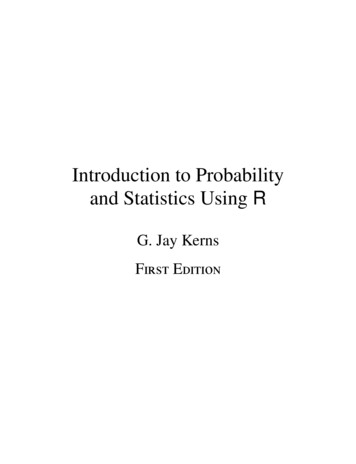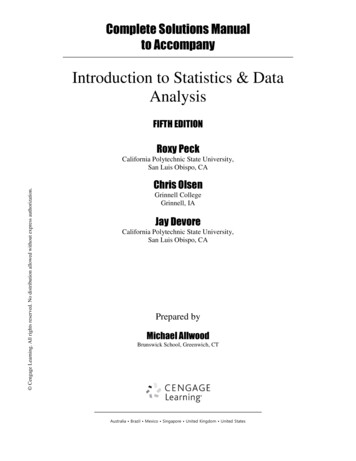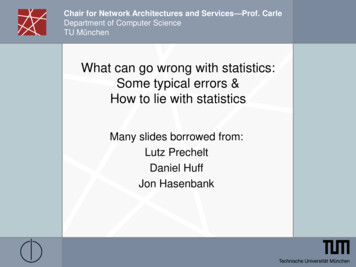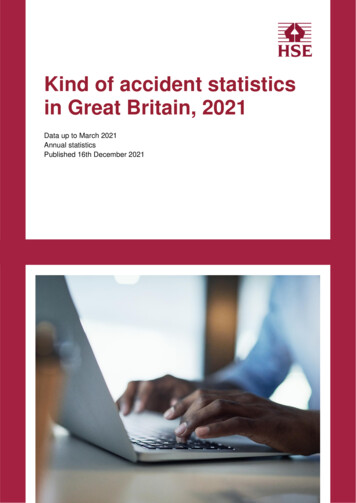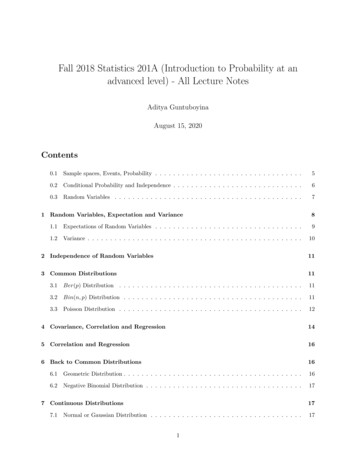
Transcription
Fall 2018 Statistics 201A (Introduction to Probability at anadvanced level) - All Lecture NotesAditya GuntuboyinaAugust 15, 2020Contents0.1Sample spaces, Events, Probability . . . . . . . . . . . . . . . . . . . . . . . . . . . . . . . . .50.2Conditional Probability and Independence . . . . . . . . . . . . . . . . . . . . . . . . . . . . .60.3Random Variables . . . . . . . . . . . . . . . . . . . . . . . . . . . . . . . . . . . . . . . . . .71 Random Variables, Expectation and Variance81.1Expectations of Random Variables . . . . . . . . . . . . . . . . . . . . . . . . . . . . . . . . .91.2Variance . . . . . . . . . . . . . . . . . . . . . . . . . . . . . . . . . . . . . . . . . . . . . . . .102 Independence of Random Variables113 Common Distributions113.1Ber(p) Distribution . . . . . . . . . . . . . . . . . . . . . . . . . . . . . . . . . . . . . . . . .113.2Bin(n, p) Distribution . . . . . . . . . . . . . . . . . . . . . . . . . . . . . . . . . . . . . . . .113.3Poisson Distribution . . . . . . . . . . . . . . . . . . . . . . . . . . . . . . . . . . . . . . . . .124 Covariance, Correlation and Regression145 Correlation and Regression166 Back to Common Distributions166.1Geometric Distribution . . . . . . . . . . . . . . . . . . . . . . . . . . . . . . . . . . . . . . . .166.2Negative Binomial Distribution . . . . . . . . . . . . . . . . . . . . . . . . . . . . . . . . . . .177 Continuous Distributions7.117Normal or Gaussian Distribution . . . . . . . . . . . . . . . . . . . . . . . . . . . . . . . . . .117
7.2Uniform Distribution . . . . . . . . . . . . . . . . . . . . . . . . . . . . . . . . . . . . . . . . .187.3The Exponential Density. . . . . . . . . . . . . . . . . . . . . . . . . . . . . . . . . . . . . .187.4The Gamma Density . . . . . . . . . . . . . . . . . . . . . . . . . . . . . . . . . . . . . . . . .188 Variable Transformations199 Distribution Functions and the Quantile Transform2010 Joint Densities2211 Joint Densities under Transformations2311.1 Detour to Convolutions . . . . . . . . . . . . . . . . . . . . . . . . . . . . . . . . . . . . . . .12 Joint Densities under transformations242512.1 Linear Transformations . . . . . . . . . . . . . . . . . . . . . . . . . . . . . . . . . . . . . . .2512.2 Invertible Linear Transformations . . . . . . . . . . . . . . . . . . . . . . . . . . . . . . . . . .2612.3 General Invertible Transformations . . . . . . . . . . . . . . . . . . . . . . . . . . . . . . . . .2713 Joint Densities under Non-Invertible Transformations2914 More on Order Statistics: The density of X(i) for a fixed i3014.1 Method One . . . . . . . . . . . . . . . . . . . . . . . . . . . . . . . . . . . . . . . . . . . . . .3014.2 Method Two . . . . . . . . . . . . . . . . . . . . . . . . . . . . . . . . . . . . . . . . . . . . .3014.3 Method Three . . . . . . . . . . . . . . . . . . . . . . . . . . . . . . . . . . . . . . . . . . . . .3114.4 Uniform Order Statistics . . . . . . . . . . . . . . . . . . . . . . . . . . . . . . . . . . . . . . .3214.5 Maximum of Independent Uniforms. . . . . . . . . . . . . . . . . . . . . . . . . . . . . . . .3214.6 Minimum of Independent Exponentials . . . . . . . . . . . . . . . . . . . . . . . . . . . . . . .3215 The Central Limit Theorem3316 Convergence in Distribution3417 The Weak Law of Large Numbers3718 Moment Generating Functions3719 Proof of the CLT using MGFs3820 Two Remarks on the CLT402
21 More on the Weak Law and Convergence in Probability4122 Slutsky’s Theorem, Continuous Mapping Theorem and Applications4323 Delta Method4724 Application of the Delta Method to Variance Stabilizing Transformations4824.1 Motivating Variance Stabilizing Transformations . . . . . . . . . . . . . . . . . . . . . . . . .4824.2 Construction of the Variance Stabilizing Transformation . . . . . . . . . . . . . . . . . . . . .4924.3 Back to the Bernoulli Example . . . . . . . . . . . . . . . . . . . . . . . . . . . . . . . . . . .4924.4 Back to the Poisson Example . . . . . . . . . . . . . . . . . . . . . . . . . . . . . . . . . . . .5024.5 Chi-squared Example . . . . . . . . . . . . . . . . . . . . . . . . . . . . . . . . . . . . . . . . .5124.6 Geometric Example51. . . . . . . . . . . . . . . . . . . . . . . . . . . . . . . . . . . . . . . . .25 Delta Method when g 0 (θ) 05226 Conditioning5326.1 Basics . . . . . . . . . . . . . . . . . . . . . . . . . . . . . . . . . . . . . . . . . . . . . . . . .5326.2 Conditional Distributions, Law of Total Probability and Bayes Rule for Discrete RandomVariables . . . . . . . . . . . . . . . . . . . . . . . . . . . . . . . . . . . . . . . . . . . . . . .5427 Conditioning for Discrete Random Variables5628 Conditional Densities for Continuous Random Variables5729 Conditional Density is Proportional to Joint Density5830 Conditional Densities and Independence5931 Law of Total Probability and Bayes Rule for Continuous Random Variables5932 Law of Total Probability and Bayes Rule for Continuous Random Variables6033 LTP and Bayes Rule for general random variables6233.1 X and Θ are both discrete . . . . . . . . . . . . . . . . . . . . . . . . . . . . . . . . . . . . . .6233.2 X and Θ are both continuous . . . . . . . . . . . . . . . . . . . . . . . . . . . . . . . . . . . .6333.3 X is discrete while Θ is continuous . . . . . . . . . . . . . . . . . . . . . . . . . . . . . . . . .6333.4 X is continuous while Θ is discrete . . . . . . . . . . . . . . . . . . . . . . . . . . . . . . . . .633
34 Conditional Joint Densities6435 Conditional Joint Densities6535.1 Application to the Normal prior-Normal data model . . . . . . . . . . . . . . . . . . . . . . .36 Conditional Expectation676936.1 Law of Iterated/Total Expectation . . . . . . . . . . . . . . . . . . . . . . . . . . . . . . . . .6936.2 Law of Iterated/Total Expectation . . . . . . . . . . . . . . . . . . . . . . . . . . . . . . . . .7036.3 Application of the Law of Total Expectation to Statistical Risk Minimization . . . . . . . . .7137 Conditional Variance7338 Random Vectors7439 Random Vectors7440 Detour – Spectral Theorem for Symmetric Matrices7540.1 Orthonormal Basis . . . . . . . . . . . . . . . . . . . . . . . . . . . . . . . . . . . . . . . . . .7540.2 Spectral Theorem . . . . . . . . . . . . . . . . . . . . . . . . . . . . . . . . . . . . . . . . . . .7640.3 Three Applications of the Spectral Theorem . . . . . . . . . . . . . . . . . . . . . . . . . . . .7740.3.1 Every symmetric positive semi-definite matrix is a Covariance Matrix . . . . . . . . .7740.3.2 Whitening . . . . . . . . . . . . . . . . . . . . . . . . . . . . . . . . . . . . . . . . . . .7840.3.3 First Prinicipal Component of a Random Vector . . . . . . . . . . . . . . . . . . . . .7841 Best Linear Predictor7842 Best Linear Predictor8043 Residual8244 Detour: Schur Complements8245 Partial Correlation8346 Partial Correlation and Inverse Covariance8447 Partial Correlation and Best Linear Predictor8648 BLP when Y is a random vector884
49 Moment Generating Functions of Random Vectors8950 The Multivariate Normal Distribution9050.1 Moment Generating Function of a Multivariate Normal . . . . . . . . . . . . . . . . . . . . .9050.2 Connection to i.i.d N (0, 1) random variables . . . . . . . . . . . . . . . . . . . . . . . . . . . .9151 Joint Density of the Multivariate Normal Distribution9152 Properties of Multivariate Normal Random Variables9153 Properties of Multivariate Normal Random Variables9354 Idempotent Matrices and Chi-Squared distributions9355 Conditional Distributions of Multivariate Normals9656 Some Remarks on Multivariate Normals and Chi-Squared Distributions9857 Conditional Distributions of Multivariate Normals99We will start the course by a review of undergraduate probability material. The review will be fairlyquick and should be complete in about six lectures.0.1Sample spaces, Events, ProbabilityProbability theory is invoked in situations that are (or can be treated as) chance or random experiments. Insuch a random experiment, the sample space is the set of all possible outcomes and we shall denote it by Ω.For example, suppose we are tossing a coin 2 times. Then a reasonable sample space is {hh, ht, th, tt}.Subsets of the sample space are called Events. For example, in the above example, {hh, ht} is an Eventand it represents the event that the first of the two tosses results in a heads. Similary, the event that at leastone of the two tosses results in a heads is represented by {hh, ht, th}.Given a collection of events A1 , A2 , . . . ,1. Ac1 denotes the event that A1 does not happen. We say that Ac1 is the complement of the event A1 .2. i 1 Ai denotes the event that at least one of A1 , A2 , . . . happens.3. i 1 Ai denotes the event that all of A1 , A2 , . . . happen.Probability is defined as a function that maps (or associates) events to real numbers between 0 and 1 andwhich satisfies certain natural consistency properties. Specifically P is a probability provided:1. 0 P(A) 1 for every event A.2. For the empty subset Φ ( the “impossible event”), P(Φ) 05
3. For the whole sample space ( the “certain event”), P(Ω) 1.4. If an event A is a disjoint union of a sequence of events A1P, A2 , . . . (this means that every point in Abelongs to exactly one of the sets A1 , A2 , . . . ), then P(A) i 1 P(Ai ).Example 0.1 (Nontransitive Dice). Consider the following set of dice:1. Die A has sides 2, 2, 4, 4, 9, 9.2. Die B has sides 1, 1, 6, 6, 8, 8.3. Die C has sides 3, 3, 5, 5, 7, 7.What is the probability that A rolls a higher number than B? What is the probability that B rolls higher thanC? What is the probability that C rolls higher than A? Assume that, in any roll of dice, all outcomes areequally likely.0.2Conditional Probability and IndependenceConsider a probability P and an event B for which P(B) 0. We can then define P(A B) for every event AasP(A B)P(A B) : .(1)P(B)P(A B) is called the conditional probability of A given B.Here is two very interesting problems from Mosteller’s delightful book (titled Fifty Challenging Problemsin Probability) illustrating the use of conditional probabilities.Example 0.2 (From Mosteller’s book (Problem 13; The Prisoner’s Dilemma)). Three prisoners, A, B, andC, with apparently equally good records have applied for parole. The parole board has decided to release twoof the three, and the prisoners know this but not which two. A warder friend of prisoner A knows who areto be released. Prisoner A realizes that it would be unethical to ask the warder if he, A, is to be released,but thinks of asking for the name of one prisoner other than himself who is to be released. He thinks thatbefore he asks, his chances of release are 2/3. He thinks that if the warder says ”B will be released,” his ownchances have now gone down to 1/2, because either A and B or B and C are to be released. And so A decidesnot to reduce his chances by asking. However, A is mistaken in his calculations. Explain.Example 0.3 (From Mosteller’s book (Problem 20: The Three-Cornered Duel)). A, B, and C are to fighta three-cornered pistol duel. All know that A’s chance of hitting his target is 0.3, C’s is 0.5, and B nevermisses. They are to fire at their choice of target in succession in the order A, B, C, cyclically (but a hit manloses further turns and is no longer shot at) until only one man is left unhit. What should A’s strategy be?We say that two events A and B are independent (under the probability P) ifP(A B) P(A).Equivalently, independence is given by P(A B) P(A)P(B) or P(B A) P(B).A very important formula involving conditional probabilities is the Bayes’ rule. This says thatP(A B) P(B A)P(A).P(B A)P(A) P(B Ac )P(Ac )Can you derive this from the definition (1) of conditional probability?Here is a very interesting application of Bayes’ rule.6(2)
Example 0.4. Consider a clinical test for cancer that can yield either a positive ( ) or negative (-) result.Suppose that a patient who truly has cancer has a 1% chance of slipping past the test undetected. On theother hand, suppose that a cancer-free patient has a 5% probabiliity of getting a positive test result. Supposealso that 2% of the population has cancer. Assuming that a patient who has been given the test got a positietest result, what is the probability that they have cancer?Suppose C and C c are the events that the patient has cancer and does not have cancer respectively. Alsosuppose that and are the events that the test yields a positive and negative result respectively. By theinformation given, we haveP( C) 0.01P( C c ) 0.05P(C) 0.02.We need to compute P(C ). By Bayes rule, we haveP(C ) P( C)P(C)0.99 0.02P( C) 0.2878.P( )P( C)P(C) P( C c )P (C c )0.99 0.02 0.05 0.98Therefore the probability that this patient has cancer (given that the test gave a positive result) is about 29%.This means, in particular, that it is still unlikely that they have cancer even though the test gave a positiveresult (note though that the probability of cancer increased from 2% to 29%).Another interesting aspect of the above calculation is thatP( ) P( C)P(C) P( C c )P (C c ) 0.99 0.02 0.05 0.98 0.0688.This means that test will yield a positive result about 7% of the time (note that only 2% of the population hascancer).Suppose now that P(C) 0.001 (as opposed to P(C) 0.02) and assume that P( C) and P( C c ) stayat 0.01 and 0.05 as before. ThenP( ) P( C)P(C) P( C c )P (C c ) 0.99 0.001 0.05 0.999 0.0509.Here the true cancer rate of 0.001 has yielded in an apparent rate of 0.05 (which is an increase by a factorof 50). Think about this in the setting where the National Rifle Association is taking a survey by asking asample of citizens whether they used a gun in self-defense during the past year. Take C to be true usage and to be reported usage. If only one person in a thousand had truly used a gun in self-defense, it will appearthat one in twenty did. These examples are taken from the amazing book titled “Understanding Uncertainty”by Dennis Lindley (I feel that every student of probability and statistics should read this book).0.3Random VariablesA random variable is a function that attaches a number to each element of the sample space. In other words,it is a function mapping the sample space to real numbers.For example, in the chance experiment of tossing a coin 50 times, the number of heads is a randomvariable. Another random variable is the number of heads before the first tail. Another random variable isthe number of times the pattern hththt is seen.Many real-life quantities such as (a) The average temperature in Berkeley tomorrow, (b) The height of arandomly chosen student in this room, (c) the number of phone calls that I will receive tomorrow, (d) thenumber of accidents that will occur on Hearst avenue in September, etc. can be treated as random variables.For every event A (recall that events are subsets of the sample space), one can associate a random variablewhich take the value 1 if A occurs and 0 if A does not occur. This is called the indicator random variablecorresponding to the event A and is denoted by I(A).7
The distribution of a random variable is, informally, a description of the set of values that the randomvariable takes and the probabilities with which it takes those values.If a random variable X takes a finite or countably infinte set of possible values (in this case, we say thatX is a discrete random variable), its distribution is described by a listing of the values a1 , a2 , . . . that it takestogether with a specification of the probabilities:P{X ai }for i 1, 2, . . . .The function which maps ai to P{X ai } is called the probability mass function (pmf) of the discrete randomvariable X.If a random variable X takes a continuous set of values, its distribution is often described by a functioncalled the probability density function (pdf). The pdf is a function f on R that satisfies f (x) 0 for everyx R andZ f (x)dx 1. The pdf f of a random variable can be used to calculate P{X A} for every set A viaZP{X A} f (x)dx.ANote that if X has density f , then for every y R,ZP{X y} yf (x)dx 0.yIt is important to remember that a density function f (x) of a random variable does not represent probability(in particular, it is quite common for f (x) to take values much larger than one). Instead, the value f (x) canbe thought of as a constant of proportionality. This is because usually (as long as f is continuous at x):1lim P{x X x δ} f (x).δ 0 δ1Random Variables, Expectation and VarianceA random variable is a function that attaches a number to each element of the sample space. In other words,it is a function mapping the sample space to real numbers.For example, in the chance experiment of tossing a coin 50 times, the number of heads is a randomvariable. Another random variable is the number of heads before the first tail. Another random variable isthe number of times the pattern hththt is seen.Many real-life quantities such as (a) The average temperature in Berkeley tomorrow, (b) The height of arandomly chosen student in this room, (c) the number of phone calls that I will receive tomorrow, (d) thenumber of accidents that will occur on Hearst avenue in September, etc. can be treated as random variables.For every event A (recall that events are subsets of the sample space), one can associate a random variablewhich take the value 1 if A occurs and 0 if A does not occur. This is called the indicator random variablecorresponding to the event A and is denoted by I(A).The distribution of a random variable is, informally, a description of the set of values that the randomvariable takes and the probabilities with which it takes those values.If a random variable X takes a finite or countably infinte set of possible values (in this case, we say thatX is a discrete random variable), its distribution is described by a listing of the values a1 , a2 , . . . that it takestogether with a specification of the probabilities:P{X ai }for i 1, 2, . . . .8
The function which maps ai to P{X ai } is called the probability mass function (pmf) of the discrete randomvariable X.If a random variable X takes a continuous set of values, its distribution is often described by a functioncalled the probability density function (pdf). The pdf is a function f on R that satisfies f (x) 0 for everyx R andZ f (x)dx 1. The pdf f of a random variable can be used to calculate P{X A} for every set A viaZP{X A} f (x)dx.ANote that if X has density f , then for every y R,ZP{X y} yf (x)dx 0.yIt is important to remember that a density function f (x) of a random variable does not represent probability(in particular, it is quite common for f (x) to take values much larger than one). Instead, the value f (x) canbe thought of as a constant of proportionality. This is because usually (as long as f is continuous at x):1lim P{x X x δ} f (x).δ 0 δThe cumulative distribution function (cdf) of a random variable X is the function defined asF (x) : P{X x}for x .This is defined for all random variables discrete or continuous. If the random variable X has a density, thenits cdf is given byZ xF (x) f (t)dt. The cdf has the following properties: (a) It is non-decreasing, (b) right-continuous, (c) limx F (x) 0and limx F (x) 1.1.1Expectations of Random VariablesLet X be a discrete random variable and let g be a real-valued function on the range of X. We then say thatg(X) has finite expectation providedX g(x) P{X x} xwhere the summation is over all possible values x of X. Note the presence of the absolute value on g(x)above.When g(X) has finite expectation, we define Eg(X) asXEg(X) : g(x)P{X x} (3)xwhere again the summation is over all possible values x of X.Analogously, if X is a continuous random variable with density (pdf) f , then we say that g(X) has finiteexpectation providedZ g(x) f (x)dx . 9
When g(X) has finite expectation, we define Eg(X) asZ Eg(X) g(x)f (x)dx.(4) Why do we need to ensure finiteness of the absolute sums (or integrals) before defining expectation? Becauseotherwise the sum in (3) (or the integral in (4)) might be ill-defined. For example, when X is the discreterandom variable which takes the values . . . , 3, 2, 1, 1, 2, 3, . . . with probabilitiesP{X i} 3 1π 2 i2for i Z, i 6 0.Then the sum in (3) for g(x) x becomesEX 3π2X 1ii Z:i6 0which can not be made any sense of. it is easy to see here thatPx x P{X x} .If A is an event, then recall that I(A) denotes the corresponding indicator random variable that equals 1when A holds and 0 when A does not hold. It is convenient to note that the expectation of I(A) preciselyequals P(A).An important thing to remember is that Expectation is a linear operator i.e.,E(aX bY ) aE(X) bE(Y )for any two random variables X and Y with finite expectations and real numbers a and b.1.2VarianceA random variable X is said to have finite variance if X 2 has finite expectation (do you know that whenX 2 has finite expectation, X also will have finite expectation? how will you prove this?). In that case, thevariance of X 2 is defined asV ar(X) : E(X µX )2 E(X 2 ) µ2Xwhere µX : E(X).It is clear from the definition that Variance of a random variable X measures the average variability in thevalues taken by X around its mean E(X).Suppose X is a discrete random variables taking finitely many values x1 , . . . , xn with equal probabilities.Then what is the variance of X?The square root of the variance of X is called the standard deviation of X and is often denoted by SD(X).The Expectation of a random variable X has the following variational property: it is the value of a thatminimizes the quantity E(X a)2 over all real numbers a. Do you know how to prove this?If the variance of a random variable X is small, then X cannot deviate much from its mean ( E(X) µ).This can be made precise by Chebyshev’s inequality which states the following.Chebyshev’s Inequality: Let X be a random variable with finite variance and mean µ. Then for every 0, the following inequality holds:P { X µ } V ar(X). 2In other words, the probability that X deviates by more than from its mean is bounded from above byV ar(X)/ 2 .10
Proof of Chebyshev’s inequality: Just argue thatI{ X µ } (X µ)2 2and take expectations on both sides (on the left hand side, we have the Indicator random variable that takesthe value 1 when X µ and 0 otherwise).2Independence of Random VariablesWe say that two random variables X and Y are independent if conditioning on any event involving Y doesnot change the probability of any event involving X i.e.,P {X A Y B} P{X A}for every A and B.Equivalently, independence of X and Y is same asP{X A, Y B} P{X A}P{Y B}for every A and B.The following are consequences of independence. If X and Y are independent, then1. g(X) and h(Y ) are independent for every pair of functions g and h.2. E (g(X)h(Y )) Eg(X)Eh(Y ) for every pair of functions g and h.More generally, we say that random variables X1 , . . . , Xk are (mutually) independent if, for every 1 i k, conditioning on any event involving Xj , j 6 i does not change the probability of any event involving Xi .From here one can easily derive properties of independence such asP{X1 A1 , . . . , Xk Ak } P{X1 A1 }P{X2 A2 } . . . P{Xk Ak }for all possible choices of events A1 , . . . , Ak .3Common Distributions3.1Ber(p) DistributionA random variable X is said to have the Ber(p) (Bernoulli with parameter p) distribution if it takes the twovalues 0 and 1 with P{X 1} p.Note then that EX p and V ar(X) p(1 p). For what value of p is X most variable? least variable?3.2Bin(n, p) DistributionA random variable X is said to have the Binomial distribution with parameters n and p (n is a positiveinteger and p [0, 1]) if it takes the values 0, 1, . . . , n with pmf given by n kP{X k} p (1 p)n kfor every k 0, 1, . . . , n.k11
Herenk is the binomial coefficient: nn!: .kk!(n k)!The main example of a Bin(n, p) random variable is the number of heads obtained in n independent tossesof a coin with probability of heads equalling p.Here is an interesting problem about the Binomial distribution from Mosteller’s book (you can easilycalculate these probabilities in R).Example 3.1 (From Mosteller’s book (Problem 19: Issac Newton helps Samuel Pepys)). Pepys wrote Newtonto ask which of three events is more likely: that a person get (a) at least I six when 6 dice are rolled, (b) atleast 2 sixes when 12 dice are rolled, or (c) at least 3 sixes when 18 dice are rolled What is the answer?Let X denote the number of heads in n independent tosses of a coin with probability of heads being p.Then we know that X Bin(n, p). If, now, Xi denotes the binary random variable that takes 1 if the ithtoss is a heads and 0 if the ith toss is a tail, then it should be clear thatX X1 · · · Xn .Note that each Xi is a Ber(p) random variable and that X1 , . . . , Xn are independent. Therefore Bin(n, p)random variables can be viewed as sums of n independent Ber(p) random variables. The Central LimitTheorem (which we will study in detail later in the class) implies that the sum of a large number of i.i.d(what is i.i.d?) random variables is approximately normal. This means that when n is large and p is held fixed,the Bin(n, p) distribution looks like a normal distribution. We shall make this precise later. In particular,this means that Binomial probabilities can be approximately calculated via normal probabilities for n largeand p fixed. From this point of view, what is the probability of getting k or more sixes from 6k rolls of a diewhen k is large?What is the mean of the Bin(n, p) distribution? What is an unbiased estimate of the probability of headsbased on n independent tosses of a coin? What is the variance of Bin(n, p)?3.3Poisson DistributionA random variable X is said to have the Poisson distribution with parameter λ 0 (denoted by P oi(λ)) ifX takes the values 0, 1, 2, . . . with pmf given byP{X k} e λλkk!for k 0, 1, 2, . . . .The main utility of the Poisson distribution comes from the following fact:Fact: The binomial distribution Bin(n, p) is well-approximated by the Poisson distribution P oi(np)provided that the quantity np2 small.To intuitively see why this is true, just see thatP {Bin(n, p) 0} (1 p)n exp (n log(1 p)) .ppNote now that np2 being small implies that p is small (note that p can be written as np2 /n np2 sosmall np2 will necessarily mean that p is small). When p is small, we can approximate log(1 p) as p p2 /2so we get P {Bin(n, p) 0} exp (n log(1 p)) exp ( np) exp np2 /2 .Now because np2 is small, we can ignore the second term above to obtain that P{Bin(n, p) 0} is approximated by exp( np) which is precisely equal to P{P oi(np) 0}. One can similarly approximateP{Bin(n, p) k} by P{P oi(np) k} for every fixed k 0, 1, 2, . . . .12
There is a formal theorem (known as Le Cam’s theorem) which rigorously proves that Bin(n, p) P oi(np)when np2 is small. This is stated without proof below (its proof is beyond the scope of this class).Theorem 3.2 (Le Cam’s Theorem). Suppose X1 , . . . , Xn are independent random variables such that Xi Ber(pi ) for some pi [0, 1] for i 1, . . . , n. Let X X1 · · · Xn and λ p1 . . . pn . Then X P{X k} P {P oi(λ) k} 2nXp2i .i 1k 0In the special case when p1 · · · pn p, the above theorem says that X P{Bin(n, p) k} P{P oi(np) k} 2np2k 0and thus when np2 is small, the probability P{Bin(n, p) k} is close to P{P oi(np) k} for each k 0, 1, . . . .An implication of this fact is that for every fixed λ 0, we have λwhen n is large.P oi(λ) Bin n,nThis is because when p λ/n, we have np2 λ2 /n which will be small when n is large.This approximation property of the Poisson distribution is the reason why the Poisson distribution isused to model counts of rare events. For example, the number of phone calls a telephone operator receivesin a day, the number of accidents in a particular street in a day, the number of typos found in a book, thenumber of goals scored in a football game can all be modelled as P oi(λ) for some λ 0. Can you justifywhy these real-life random quantities can be modeled by the Poisson distribution?The following example presents another situation where the Poisson distribution provides a good approximation.Example 3.3. Consider n letters numbered 1, . . . , n and n envelopes numbered 1, . . . , n. The right envelopefor letter i is the envelope i. Suppose that I take a random permutation σ1 , . . . , σn of 1, . . . , n and then placethe letter σi in the envelope i. Let X denote the number of letters which are in their right envelopes. Whatis the distribution of X?Let Xi be the random variable which takes the value 1 when the ith letter is in the ith envelope and 0otherwise. Then clearly X X1 · · · Xn . Note thatP{Xi 1} 1nfor each i 1, . . . , n.This is because the ith letter is equally likely to be in any of the n envelopes. This means therefore thatXi Ber(1/n)for i 1, . . . , n.If the Xi ’s were also independent, then X X1 · · · Xn will be Bin(n, 1/n) which is very close to P oi(1)for large n. But the Xi ’s are not independent here because for i 6 j,P {Xi 1 Xj 1} 116 P {Xi 1} .n 1nHowever, the dependence is relatively weak and it turns out that the distribution of X is quite close to P oi(1).We shall demonstrate this by showing that P{X 0} is approximately equal to P{P oi(1) 0} e 1 . I willleave as an exercise to show that P{X k} P{P oi(1) k} for every fixed k. To compute P{X 0}, we13
can writeP{X 0} P{ EnY(1 Xi ) 1}i 1nY(1 Xi )i 1 E nX1 1 Xi i 1XXXi Xj i jE(Xi ) iXXXi Xj Xk · · · ( 1)n X1 . . . Xn i j kE(Xi Xj ) i j XE(Xi Xj Xk ) · · · ( 1)n E(X
C? What is the probability that C rolls higher than A? Assume that, in any roll of dice, all outcomes are equally likely. 0.2 Conditional Probability and Independence Consider a probability P and an event Bfor which P(B) 0. We can then de ne P(AjB) for every event A as P(AjB) : P(A\B) P(B): (1) P(AjB) is called the conditional probability of .
